| Article ID | Journal | Published Year | Pages | File Type |
|---|---|---|---|---|
| 682428 | Bioresource Technology | 2010 | 10 Pages |
Caproate always appears during fermentative H2H2 production but its formation was not well explained. It possibly results from the secondary fermentation of ethanol and acetate or butyrate by some special species like Clostridium kluyveri . This study attempts to elucidate caproate formation during the fermentation H2H2 production by using C. kluyveri as an example and evaluating several possible pathways of caproate formation. A detailed energetic analysis of the empirical data of an H2H2-producing reactor demonstrated that caproate can be formed from two substrates, either ethanol and acetate or ethanol and butyrate. The analysis showed that at least 5 mol ethanol per mole reaction was essential to support caproate formation under the experimental condition. The analysis also indicated that the secondary fermentation by C. kluyveri might be another pathway to spontaneously produce H2H2, butyrate, and acetate in addition to the butyrate-acetate pathway. Co-production of caproate and H2H2 from ethanol was thermodynamically feasible and contributed to at least 10–20% of total H2H2 production in the reactor studied. It is also clarified that caproate formation is hydrogenogenic rather than hydrogenotrophic.
